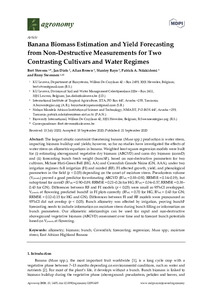| dc.contributor.author | Stevens, B. |
| dc.contributor.author | Diels, J. |
| dc.contributor.author | Brown, A. |
| dc.contributor.author | Bayo, S. |
| dc.contributor.author | Ndakidemi, P. A. |
| dc.contributor.author | Swennen, R. |
| dc.date.accessioned | 2022-08-23T12:01:06Z |
| dc.date.available | 2022-08-23T12:01:06Z |
| dc.date.issued | 2020-09-21 |
| dc.identifier.citation | Stevens, B., Diels, J., Brown, A., Bayo, S., Ndakidemi, P. A., & Swennen, R. (2020). Banana biomass estimation and yield forecasting from non-destructive measurements for two contrasting cultivars and water regimes. Agronomy, 10(9): 1435, 1-26. |
| dc.identifier.issn | 0002-1962 |
| dc.identifier.uri | https://hdl.handle.net/20.500.12478/7679 |
| dc.description.abstract | The largest abiotic constraint threatening banana (Musa spp.) production is water stress, impacting biomass buildup and yields; however, so far no studies have investigated the effects of water stress on allometric equations in banana. Weighted least square regression models were built for (i) estimating aboveground vegetative dry biomass (ABGVD) and corm dry biomass (cormD) and (ii) forecasting bunch fresh weight (bunchF), based on non-destructive parameters for two cultivars, Mchare Huti-Green Bell (HG, AA) and Cavendish Grande Naine (GN, AAA), under two irrigation regimes: full irrigation (FI) and rainfed (RF). FI affected growth, yield, and phenological parameters in the field (p < 0.05) depending on the onset of moisture stress. Pseudostem volume (Vpseudo) proved a good predictor for estimating ABGVD (R2adj = 0.88–0.92; RRMSE = 0.14–0.19), but suboptimal for cormD (R2adj = 0.90–0.89, RRMSE = 0.21–0.26 for HG; R2adj = 0.34–0.57, RRMSE = 0.38–0.43 for GN). Differences between RF and FI models (p < 0.05) were small as 95%CI overlapped. Vpseudo at flowering predicted bunchF in FI plots correctly (R2adj = 0.70 for HG, R2adj = 0.43 for GN; RRMSE = 0.12–0.15 for HG and GN). Differences between FI and RF models were pronounced as 95%CI did not overlap (p < 0.05). Bunch allometry was affected by irrigation, proving bunchF forecasting needs to include information on moisture stress during bunch filling or information on bunch parameters. Our allometric relationships can be used for rapid and non-destructive aboveground vegetative biomass (ABGVD) assessment over time and to forecast bunch potentials based on Vpseudo at flowering. |
| dc.description.sponsorship | Belgian VLIR-UOS VLADOC scholarship |
| dc.description.sponsorship | CGIAR Research Program for Roots, Tubers, and Bananas |
| dc.format.extent | 1-26 |
| dc.language.iso | en |
| dc.subject | Allometry |
| dc.subject | Biomass |
| dc.subject | Forecasting |
| dc.subject | Regression Analysis |
| dc.title | Banana biomass estimation and yield forecasting from non-destructive measurements for two contrasting cultivars and water regimes |
| dc.type | Journal Article |
| cg.contributor.crp | Agriculture for Nutrition and Health |
| cg.contributor.crp | Roots, Tubers and Bananas |
| cg.contributor.affiliation | Katholieke Universiteit Leuven |
| cg.contributor.affiliation | International Institute of Tropical Agriculture |
| cg.contributor.affiliation | The Nelson Mandela African Institution of Science and Technology (NM-AIST) |
| cg.coverage.region | Africa |
| cg.coverage.region | West Africa |
| cg.coverage.country | Nigeria |
| cg.coverage.hub | Eastern Africa Hub |
| cg.researchtheme | Biotech and Plant Breeding |
| cg.identifier.bibtexciteid | STEVENS:2020a |
| cg.isijournal | ISI Journal |
| cg.authorship.types | CGIAR and advanced research institute |
| cg.iitasubject | Agronomy |
| cg.iitasubject | Banana |
| cg.iitasubject | Plant Breeding |
| cg.journal | Agronomy |
| cg.notes | Published online: 21 Sep 2020 |
| cg.accessibilitystatus | Open Access |
| cg.reviewstatus | Peer Review |
| cg.usagerightslicense | Creative Commons Attribution 4.0 (CC BY 0.0) |
| cg.targetaudience | Scientists |
| cg.identifier.doi | https://dx.doi.org/10.3390/agronomy10091435 |
| cg.iitaauthor.identifier | Allen Brown: 0000-0002-4468-5932 |
| cg.iitaauthor.identifier | Rony Swennen: 0000-0002-5258-9043 |
| cg.futureupdate.required | No |
| cg.identifier.issue | 9 |
| cg.identifier.volume | 10 |

